Erica uysii
Erica uysii H.A.Baker
Family: Ericaceae
Common names: De Hoop bell heath, Uys’ heath (Eng.) De Hoop-klokkiesheide, Uys-heide (Afr.)
Introduction
Erica uysii starts to form flower buds by the middle of August and fully presents light to dark pink flowers in September and October.
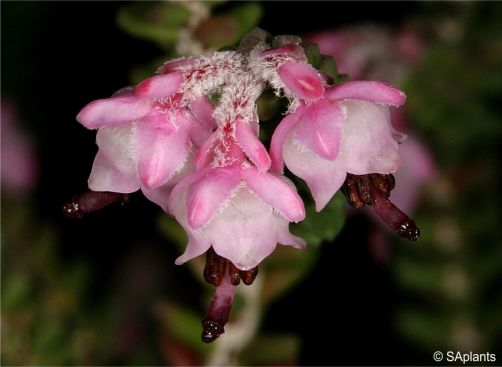
Description
Description
The plant forms quite a vigorous upright woody shrub in its natural environment and can reach a height of up to 2 m when fully grown. However, it is observed to get only about 600–800 mm tall when growing outside its ideal environment. The brittle branches point upwards, with many branchlets carrying spreading, 3-nate, ±1 mm long, grey leaves. The branches are densely covered with short woolly hairs (tomentose), becoming hairless. The flowers are usually 3-nate but sometimes 4-nate and are carried terminally (at the tip of a branchlet) and may appear to be axillary where the branchlets fail to develop. The corolla is rose pink, 4 mm long, rounded to urn shaped with a slightly narrowing throat. The sepals are also pink, and keeled which gives them a slightly square appearance. The flowers are borne on tomentose pedicels that are 3.5 mm long, the flowers bent downwards. The stamens are protruding and the anthers are dark brown and awned (with a fine horn-like appendage at the base of the anther cell). The style and stigma are also protruding. Flowering time is in spring (September to October).
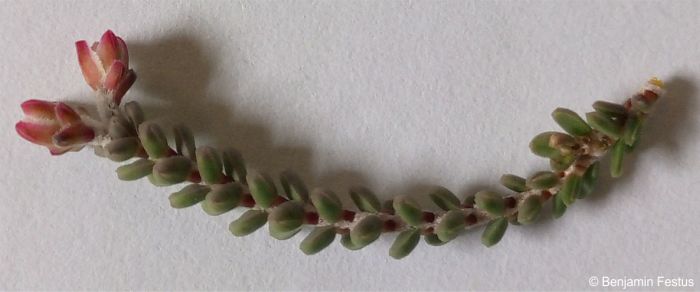
Conservation Status
Status
According to the SANBI Red List of South African Plants, Erica uysii is currently assessed as Vulnerable and it is a rare species known from only one subpopulation of about 500 plants. The plant is mainly threatened by alien invasive Acacia cyclops infestations, ongoing monitoring of this threat is a must, however, the population trend is currently recorded as stable.
Distribution and habitat
Distribution description
Erica uysii is endemic to southern Africa and has a Western Cape distribution. The species is restricted to limestone soil types and grows among rocks along the shore of the De Hoop Vlei. When found away from rocks it still prefers lime substrates and to be near water.
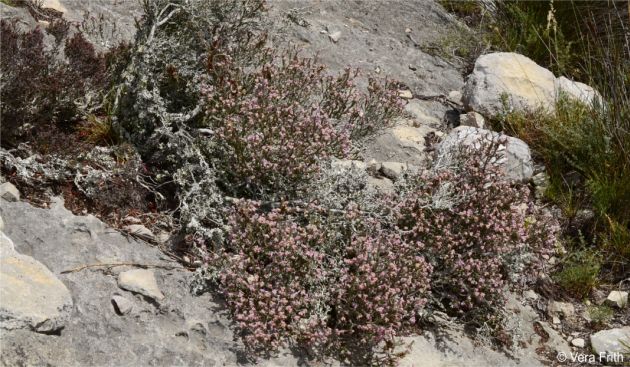
Derivation of name and historical aspects
History
This species is named after Dr Peter Uys, a South African doctor of medicine and anaesthetist, who found the plant on 3 September 1972 when he was a fifth-year medical student, walking with his father, a birder, at Melkkamer, on the banks of the De Hoop Vlei in Wasdam se Kloof. Peter was more interested in the plants, and while walking towards the dunes, he spotted this Erica growing among the limestone rocks on north-facing cliffs. He took a specimen to John Rourke at the Compton Herbarium for identification. Rourke referred him to the Erica expert Hugh Baker, who recognised it as an undescribed species. Baker described it in the Journal of South African Botany in 1973, naming it after Peter Uys in recognition of the quality of the specimens Peter provided that enabled him to undertake a proper analysis of the plant and to deposit good specimens in the herbaria afterwards. Hugh Baker (1896-1976) was a retired British Army colonel and amateur botanist who settled in Cape Town. He developed an interest in the southern African flora and became an expert on the genus Erica while helping to rebuild the Erica collection at the British Museum (Natural History), describing 36 new species and publishing 16 papers and a book on ericas.
The genus name Erica derives from the Latin word ereiko which means heath or broom. The genus comprises ±800 species, of which ±700 species are indigenous to South Africa, and ±600 of these species are found in the Cape Floristic Kingdom alone.
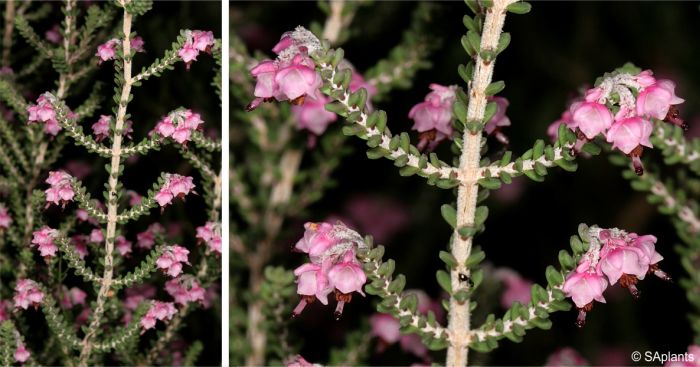
Ecology
Ecology
Erica uysii has been observed to be visited by insects. Pollinators play an important role in the continual survival of the plant, they contribute to the pollination process by visiting different flowers. Pollinators get rewarded with nectar from the plant.
The greyish leaves of the plant are covered with fine hairs, these features may contribute to preventing excessive water loss by reflecting sunlight from the grey leaves and trapping moisture by the hairs. Some ericas have developed features such as wax-like, hairy or extremely sticky flowers which may serve to protect the plant. Erica seeds are usually very tiny and can remain dormant in the soil for long periods until the environmental conditions, such as soil moisture and temperature, become favourable to stimulate germination.
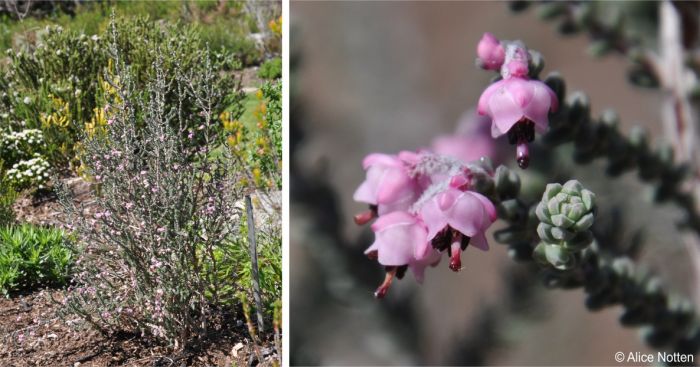
Uses
Use
Erica uysii makes an excellent pot plant, providing good drainage is essential. This plant will add interest to any display garden, especially when planted with other fynbos plants, such as buchus, restios and conebushes. It is ideally suited to coastal fynbos gardens with alkaline or neutral soil, but will also grow in fynbos gardens with acidic soil.
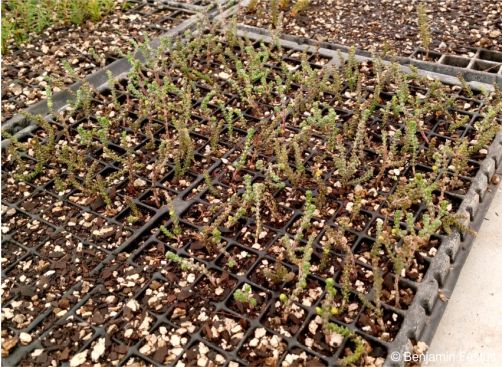
Growing Erica uysii
Grow
Erica uysii grows naturally in limestone soil but can easily adapt to growing in soil with an acidic pH ranging from 5.5-6.7, it also grows best in a full sun position. This plant prefers soil with good drainage especially when planted in pots. Prune the plant after flowering, this will encourage new growth. The removal of senescent and damaged wood will also give the plant a neat appearance. Apply matured compost sparingly when planting directly into the ground. Use organic fertiliser to feed the plant, ericas do not respond well to chemical fertiliser.
This plant can be successfully propagated by taking heel cuttings, ideally two months after flowering. Use a 50:50 ratio of fine-milled bark and perlite as the propagation medium. Propagation of this plant by cuttings is the preferred method, seed sowing is a longer process because seeds need to be treated, for example by soaking it in a ‘fynbos smoke liquid’ (an extract from burning fynbos plants) before sowing. Seeds will also take longer before they reach a stage where it is ready for planting in the garden.
Transplant rooted cuttings into small pots, once the root system has been well developed. Use a mixture of 7 parts milled bark and 3 parts sand, and harden the cuttings off for a month. Feed the rooted cuttings with an organic liquid fertiliser applied every two weeks. The cuttings can be planted in garden beds after about three months, by this time the root ball would have developed well.
Fungal attacks on young plants in a propagation unit can be prevented or controlled by providing good air circulation. The common pests that attack young erica plants are mealybug, scale insects and red spider mites, use an organic or systemic pesticide to control them. Prevent root rot by planting in soil or a potting mix with good drainage.
References
- Baker, H.A. 1973. New taxa in the genus Erica. Journal of South African Botany 39(1):205–211.
- Biodiversity Explorer. Erica uysii. https://www.biodiversityexplorer.info/plants/ericaceae/erica/erica_uysii.htm. Accessed 5 Aug 2024.
- Frith, V. 2022-Oct. Observation of Erica uysii, Vanderstelskraal near De Hoop, WC. iNaturalist. Online. https://www.inaturalist.org/observations/140768661.
- Goldblatt, P. & Manning, J. 2000. Cape Plants. A conspectus of the Cape flora of South Africa. Strelitzia 9. National Botanical Institute, Pretoria & Missouri Botanical Garden, Missouri.
- JSTOR Global Plants. Holotype of Erica uysii H.A.Baker. https://plants.jstor.org/stable/pdf/10.5555/al.ap.specimen.nbg0097590-0. Accessed 8 August 2024.
- Plants of the World Online. Erica uysii H.A. Baker. https://powo.science.kew.org/taxon/urn:lsid:ipni.org:names:329832-1. Accessed 5 August 2024.
- Rourke, J. 1976. Col. H.A. Baker. Veld & Flora 62(4):18. https://journals.co.za/doi/pdf/10.10520/AJA00423203_4317.
- SAplants. 2010-Sep. Image of Erica uysii flowers, Kirstenbosch National Botanical Garden, Cape Town. Wikimedia Commons. https://commons.wikimedia.org/wiki/File:Erica_uysii_1DS-II_3-5166.jpg.
- SAplants. 2010-Sep. Image of Erica uysii, Kirstenbosch National Botanical Garden, Cape Town. Wikimedia Commons. https://commons.wikimedia.org/wiki/File:Erica_uysii_1DS-II_5654.jpg.
- Schumann, D., Kirsten, G. & Oliver, E.G.H. 1992. Ericas of South Africa. Fernwood Press, Vlaeberg.
- Turner, R.C., Oliver, E.G.H. & Pillay, D. 2007. Erica uysii H.A.Baker. National Assessment: Red List of South African Plants. http://redlist.sanbi.org/species.php?species=1820-913.
Credits
Benjamin Festus
Kirstenbosch National Botanical Garden
September 2024
Acknowledgements: the author thanks Vera Frith, SAplants and Alice Notten for additional images and Peter Uys for recounting to Alice Notten when and where he found this species.
Plant Attributes:
Plant Type: Shrub
SA Distribution: Western Cape
Soil type: Sandy, Loam
Flowering season: Spring
PH: Acid, Alkaline, Neutral
Flower colour: Pink
Aspect: Full Sun
Gardening skill: Average
Special Features:
Horticultural zones







Rate this article
Article well written and informative
Rate this plant
Is this an interesting plant?
Login to add your Comment
Back to topNot registered yet? Click here to register.